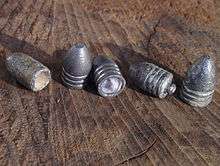Williams cleaner bullet

Three types of projectiles known as Williams Patent "cleaner" bullets were used by the Union Army during the American Civil War in the standard .58 caliber rifle muskets. There was a fourth developed for use in the Union Repeating or "Coffee-Mill" gun. The inventor was Elijah D. Williams of Philadelphia, Penn, who filed an application for his patent on May 30, 1861. It was issued almost a year later, on May 13, 1862, but field trials on his "improved" bullet had already begun.
The concept of the design was that the discharge of the musket would drive the concave disks forward thus expanding against the walls of the interior barrel removing excess black powder build up and soft lead residue from the lands in a rifled musket barrel.
Models
Type I bullets have a central post and two zinc disks with six slits. Type I cartridges can be found in both tan and blue cartridge paper. Type II and III's have a zinc base "plunger" (similar to a flat washer), and one disk without slits. Type II cleaner cartridges can be found in both white and tan cartridge paper. Type III cartridges can be found in red, blue and tan cartridge paper. Type III bullets are also the shorter of the three designed for rifle muskets. The fourth type for the "Coffee Mill" gun which at first looks like the standard Type III is slightly larger in diameter. A vernier caliper would be needed to confirm.
According to "Round Ball to Rim Fire part 1" by Dean S. Thomas, in 1863 there is also mention of a .69 caliber version of the Williams cleaner bullet but none were ever purchased by the Ordnance Dept.
At first the standard package of 10 arsenal-issued cartridges contained eleven percussion caps in a separate tube and one Williams patent cartridge out of the 10 cartridges. Later this amount was increased to three of the 10 and then to six by August 1864. Originally Soldiers were instructed to use the special bullets as every tenth round fired.
Williams cartridges were made up in the same fashion as the standard .58 caliber cartridge with 60 grains of black powder, but no official documentation has ever been located indicating that the cartridges should be made up in a colored cartridge paper. Surviving examples show blue, red, green and a white / off white cartridge paper used along with the standard "buff" tan cartridge paper in their production.
Effectiveness
Since the Williams bullets did not have a hollow base like a standard Minié ball, they were not as accurate and their cleaning effectiveness was dubious at best. Most relic bullets are found as drops, discarded by veteran soldiers in the field.
References
- Most of the information above can be found in the Dean S. Thomas book "Round Ball to Rim Fire -Part 1" chapter 13 pages 211-243 on Civil War Small Arms ammunition. Mr. Thomas is considered the foremost authority on Civil War small arms ammunition.
- For further information, consult Civil War Projectiles II by Mason and McKee, or "Round Ball to Rim Fire-Part 1" by Dean S. Thomas - 1997.